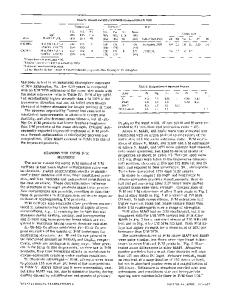Microstructure and Mechanical Behavior of FeNiCoCr and FeNiCoCrMn High-Entropy Alloys Fabricated by Powder Metallurgy
- PDF / 1,908,021 Bytes
- 10 Pages / 595.276 x 790.866 pts Page_size
- 90 Downloads / 348 Views
Microstructure and Mechanical Behavior of FeNiCoCr and FeNiCoCrMn High‑Entropy Alloys Fabricated by Powder Metallurgy Chenliang Chu1 · Weiping Chen1 · Zhen Chen1,2 · Zhenfei Jiang1 · Hao Wang1 · Zhiqiang Fu1 Received: 9 June 2020 / Revised: 5 August 2020 / Accepted: 14 August 2020 © The Chinese Society for Metals (CSM) and Springer-Verlag GmbH Germany, part of Springer Nature 2020
Abstract The present work reports a systematic investigation on phase evolution, microstructure and microstructure–property relationship of two typical face-centered cubic (FCC) structured high-entropy alloys (HEAs), FeNiCoCr and FeNiCoCrMn, prepared via mechanical alloying (MA) followed by spark plasma sintering (SPS). Following 50 h of MA, the two HEAs consisted of a mixture of FCC and body-centered cubic phases. Following SPS, the bulk FeNiCoCr alloy showed a primary FCC phase with a small amount of Cr23C6 and Cr2O3 contaminants, while the bulk FeNiCoCrMn alloy was composed of a primary FCC phase with some (Cr,Mn)23C6 and MnCr2O4 contaminants. The average grain size of the primary FCC phase in the bulk FeNiCoCr alloy was ~ 416 nm, while that of the primary FCC phase in the bulk FeNiCoCrMn alloy was ~ 547 nm. The yield strength, compressive strength and strain-to-failure of the bulk FeNiCoCr alloy are 1525 MPa, 1987 MPa and 24.4%, respectively, whereas those of the bulk FeNiCoCrMn alloy are 1329 MPa, 1761 MPa and 21.9%, respectively. It suggests that the bulk FeNiCoCrMn exhibited lower strength and plasticity in comparison with the bulk FeNiCoCr alloy. Clearly, the smaller grain size of the primary FCC phase in the FeNiCoCr alloy is mainly responsible for the better mechanical performance. Keywords High-entropy alloy · Mechanical alloying · Microstructure · Strengthening · Contaminants
1 Introduction With the number of alloying elements increases, intermetallic compounds (IMCs) or other complicated phases are likely to form in conventional alloy systems, resulting in complex microstructures and disappointing mechanical properties. A novel kind of alloys, high-entropy alloys (HEAs), proposed by Yeh et al. in 2004 have broken through the traditional alloy design strategy [1]. Up-to-date, HEAs are usually regarded as multi-principal element alloys displaying at least four principal elements with 5–35 at.% concentrations for each element [2]. In light of multi-principal element compositions, HEAs show notably higher configurational entropy than conventional alloys with one or two principal elements, Available online at http://link.springer.com/journal/40195. * Zhiqiang Fu [email protected]; [email protected] 1
Guangdong Key Laboratory for Advanced Metallic Materials Processing, South China University of Technology, Guangzhou 510640, China
Shantou Technician College, Shantou 515041, China
2
referring to high entropy effect. It has been proposed that the high entropy effect of HEAs tends to suppress the formation of IMCs, thereby allowing them to form solid solutions with simple face-centered cubic (FCC) and/or body-
Data Loading...











